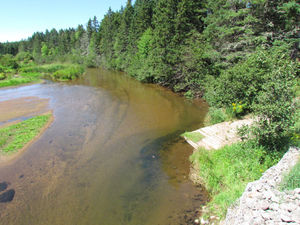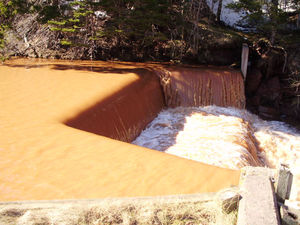Environmental group does shout out for more community engagement
These days snow clings to the banks of the Montague-Valleyfield River system, but work is being done indoors to improve the health of the 176 km of tributaries, streams and rivers in the system.
A new watershed management plan is being assembled by the Southeast Environment Association (SEA).
Executive director Jackie Bourgeois said with provincial funding now available the non-profit organization has the ability to do more to protect and maintain not only the Valleyfield-Montague watershed, but also the five others, Boughton, Cardigan, Brudenell, Sturgeon and Murray Rivers as well as all their subsidiaries in SEA’s catchment area. It is the largest single watershed area on PEI and covers approximately 730 square kilometers.
Ms Bourgeois said whether as volunteers or becoming members, residents are key to the success of the projects SEA takes on.
The management plan will look at the entire Valleyfield-Montague system, but there are areas of concern, one of which is a stretch of the Valleyfield River in the Loane Road area, known locally as the Valleyfield Ponds.
Silt is settling in, covering the rich pebbly bottom, robbing wildlife species of valuable habitat.
There are three options, Ms Bourgeois said.
Leave it as is, dig it out or dig some out and brush mat the area to catch future silt.
Either way, it is a big project and just one of the topics where community input is being sought.
“We want to hear from people from the community.
We are here to do projects that will engage them, things they would like to see done,” Ms Bourgeios said.
Residents in the watershed area will have a chance to participate in any of the four workshops being held in January and February in Iona, Heatherdale, Lower Montague and Montague.
“We want people to come out and talk, have a discussion about what they would like to see in the plan. Whether it’s things they’d like to see developed or areas they are concerned about,” Ms Bourgeois said.
A final review of the management plan will take place on Thursday, March 10 at 6:30pm at the Rural Action Centre in Montague
The face of SEA, which has been in operation since the early 1990s, has changed over the years and Ms Bourgeois said now is the perfect time for even more improvements.
In the past, the major source of funding came from the federal pot but with limitations.
Planning, monitoring and research were the three things it had to be used for and because it was federal, that prevented them from accessing other funding opportunities to follow through with projects, Ms Bourgeois said.
Now, the core funding regime that comes from the province gives the group more freedom, nonetheless, additional resources are not just handed over.
“Engagement from the community has an impact on funding,” Ms Bourgeois said, pointing to SEA’s success in developing a pollinator park in Montague.
Funding from TD Friends of the Environment Foundation, Valleyfield Community Council, the Town of Montague and the province made that project possible.
There are several federal grants SEA can access to follow through on watershed work, but a crucial part of the application is community involvement.
“Really, to be affective we need to be doing what’s meaningful to people in the community,” Ms Bourgeois said.
By the same token, volunteers will go a long way towards completing those projects.
“We’re hoping people will come out to these meetings, learn about what we are doing, sign on as a volunteer and/ or purchase a membership.
“Anything having to do with the environment, we want to hear about,” Ms Bourgeois said.
Meeting times are as follows January 20, 6:30pm at Iona Community Centre; January 26, 6:30pm Heatherdale Hall; February 3, 7:30pm at Lower Montague Community Centre and February 11, 6:30pm at Montague at the Rural Action Centre.
January 13, 2016




Leave a Comment